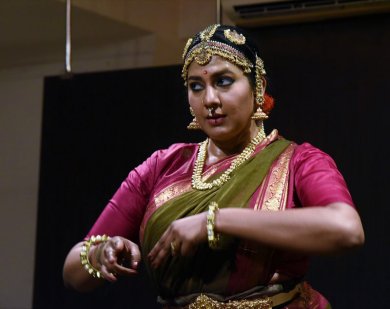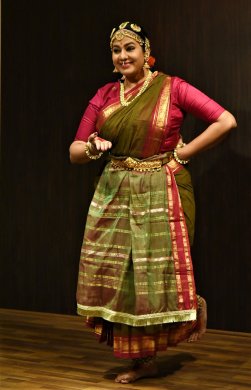
|
 |

|
 |
Swarnamalya Ganesh on research in dance - Shveta Arora e-mail: shwetananoop@gmail.com Pics: Anoop Arora July 8, 2018  Recently, I watched a most interesting performance of Sadir. It was a first for me. The fact that it was Bharatanatyam, but the performance very different from what a regular Bharatanatyam recital looks like, made me want to understand more about the research that goes into the production. Swarnamalya Ganesh is a dancer, who has been researching not just Bharatanatyam pieces to be performed, but also the dance itself - how it was influenced by cultural and political changes, who practised it, their lives and society, and the more secular repertoire that said a lot about all of this. Here is an interview about a recent performance in Delhi called When Stories Take Form, in which she presented stories about the settings and audience for Bharatanatyam - or Sadir - during the colonial rule in the Madras Presidency. Please tell us a little about the performance and how you develop the content. The performance was based on Sadir, and I had the experience of learning from hereditary community artists. I was also prodding towards understanding Bharatanatyam from the point of view of Sadir. Which is why we renamed my performance and practice over a decade ago as Sadir, and not Bharatanatyam, because I felt that the context of the dance is as important as its content. Sometimes, I might be reconstructing or reviving certain repertoires. 'When Stories Take Form' originated from the idea that there are so many interesting tales that are hidden behind every single piece that we perform. However, when we see a performance, it only allows you to think about the meaning of the songs, the ragas used. We do not think of the stories behind them and the lives of the people performing them. It was in that context that I thought it would be interesting to showcase the stories behind each of these dances, thereby building the larger narrative for what this dance form itself was.  How about the research for the production - did you do it over a period of time, and did you take somebody's help? This work and research has been a part of my doctoral and post-doctoral work. So, looking at the times and going back to archival work, theoretically and practically, the content and the research, and reviving the repertoire, was by me. As for this performance, for some aspects like clarifying something, the meaning of some song, I did seek help, but the larger part of the research was done by me. What was the importance of the period and the British influence at that time in structuring the culture of dance? If we are looking at the late 18th century and 19th century, we are looking at a strong colonial presence, and I have focused on the Madras Residency. It is very interesting to look at a story from the perspective of where it was set. Politically and geographically, it was located in the Madras Residency and within the Madras Residency also, under the colonial influence. What happened to Sadir at that time - that scenario makes a very engaging narrative. The more I thought of it, the more I realized that when you think of a Devadasi, you think only of the temple, but you realize that outside the temple, they have a very strong social presence. It is interesting to showcase a time where you see the transition from the temple to more urban spaces, more metropolitan spaces, and what happened to the dance and the dancer in the process. Kathak, which was essentially a kathakar tradition, under the Mughals and British it came to be seen as a courtesan's profession. Did this kind of influence affect Sadir under British rule? Historically, the British - the East India Company and the Crown - had very little opinion about the performing arts. Performing arts was something connected to the indigenous natives. That's about it. The policy was not to interfere in the local culture. However, because of the missionary movement and the influence of British culture and their 'ideas and morality', over time, there came to be opinion about what these art forms represented or what values they held. That debate took place a little later. But in the early times, which I was talking about in the production, they were still consuming it as part of Indian culture, the local culture. So much of it was observed and even documented by them, and of course, an opinion was given, but that opinion was not to have any political or social effect, at least not until after 1910. The last piece you performed, the salute, was very interesting. Yes, it was part of my research, a revised composition from one of the traditional repertoires of the devadasis. It was taught to me by my teacher in Viralimalai, performed during the temple festival. The gestures etc. were all by the devadasis themselves, so it shows how progressive they were. Contact Swarnamalya Ganesh at: swarnamalya@gmail.com Post your comments Unless you wish to remain anonymous, please provide your name and email id when you use the Anonymous profile in the blog to post a comment. All appropriate comments posted with name & email id in the blog will also be featured in the site. |